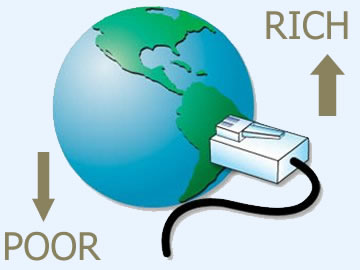High Speed Internet Gap Between Poor and Rich widening : UN
| The Graph Showing the % Interenet Users for 100 Peoples, Based on World Bank's Public Data. It shows marked difference among developed, developing and under developed nations |
 |
| The Widening Gap |
Various minimum bandwidths have been used in definitions of broadband, ranging up from 64 kbit/s up to 2.0 Mbit/s. The 2006 OECD report is typical by defining broadband as having download data transfer rates equal to or faster than 256 kbit/s, while the United States (US) Federal Communications Commission (FCC) as of 2009, defines "Basic Broadband" as data transmission speeds exceeding 768 kilobits per second (Kbps), or 768,000 bits per second, in at least one direction: downstream (from the Internet to the user’s computer) or upstream (from the user’s computer to the Internet). The trend is to raise the threshold of the broadband definition as the marketplace rolls out faster services.
"Broadband penetration" is now treated as a key economic indicator.
While the “digital divide” between rich and poor countries may be shrinking overall, the gap is widening between the developed and developing worlds in the availability of broadband or high-speed Internet, a crucial tool for achieving economic and social goals, a top United Nations official said . “Australia, for example, a country with 21 million people has more broadband subscribers than the whole of Africa [a continent with nearly 900 million inhabitants],” UN Under-Secretary-General for Communications and Public Information Kiyo Akasaka told the fourth World Electronic Media Forum in Mexico City.
He stressed that enhanced broadband connectivity can improve access to life-saving health care and information, provide opportunities for skills development and lifelong learning, lower costs for business, and connect farmers to markets, migrants to their families, and citizens to their governments.
“A person in a developed country is on average 200 times more likely than someone in a least developed country to enjoy high-speed access to the Internet,” he said, noting that in the case of Internet use, more than half of the developed world population is now online, compared to only 15 per cent in developing countries. At the start of this year, there were about 4 billion mobile subscriptions worldwide. “Mobile phones have become one of the most equitably distributed ICTs (information and communication technology),” Mr. Akasaka said. “This is good news. But while the ‘digital divide’ between rich and poor may be shrinking, it is still a major concern.”
